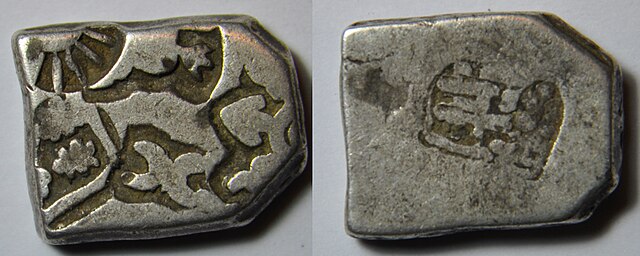The Lion Capital of Ashoka is the capital, or head, of a column erected by the Mauryan emperor Ashoka in Sarnath, India, c. 250 BCE. Its crowning features are four life-sized lions set back to back on a drum-shaped abacus. The side of the abacus is adorned with wheels in relief, and interspersing them, four animals, a lion, an elephant, a bull, and a galloping horse follow each other from right to left. A bell-shaped lotus forms the lowest member of the capital, and the whole 2.1 metres (7 ft) tall, carved out of a single block of sandstone and highly polished, was secured to its monolithic column by a metal dowel. Erected after Ashoka's conversion to Buddhism, it commemorated the site of Gautama Buddha's first sermon some two centuries before.

Four Asiatic lions stand back to back on a circular abacus. The Buddhist wheel of the moral law appears in relief below each lion. Between the chakras appear four animals in profile—horse, bull, elephant, and lion. The architectural bell below the abacus, is a stylized upside-down lotus
The Dhamek Stupa in Sarnath, a watercolour by Abdullah, Shaikh, January 1814 (sketch); 1819 (colour)
F. O. Oertel's plan of excavation. The Lion Capital was found in 1905 to the west of the main shrine, which is to the north of the "Jagat Singh" stupa.
The excavation site two years later
The Maurya Empire was a geographically extensive Iron Age historical power in South Asia based in Magadha. Founded by Chandragupta Maurya in 322 BCE, it existed in loose-knit fashion until 185 BCE. The empire was centralized by the conquest of the Indo-Gangetic Plain; its capital city was located at Pataliputra. Outside this imperial centre, the empire's geographical extent was dependent on the loyalty of military commanders who controlled the armed cities scattered within it. During Ashoka's rule, the empire briefly controlled the major urban hubs and arteries of the Indian subcontinent excepting the deep south. It declined for about 50 years after Ashoka's rule, and dissolved in 185 BCE with the assassination of Brihadratha by Pushyamitra Shunga and foundation of the Shunga dynasty in Magadha.
Pataliputra, capital of the Mauryas. Ruins of pillared hall at Kumrahar site.
The Pataliputra capital, discovered at the Bulandi Bagh site of Pataliputra, 4th–3rd c. BCE.
A silver coin of 1 karshapana of the Maurya empire, period of Bindusara Maurya about 297–272 BC, workshop of Pataliputra. Obv: Symbols with a sun. Rev: Symbol. Dimensions: 14 × 11 mm. Weight: 3.4 g.
Lion Capital of Ashoka at Sarnath. c. 250 BCE.







